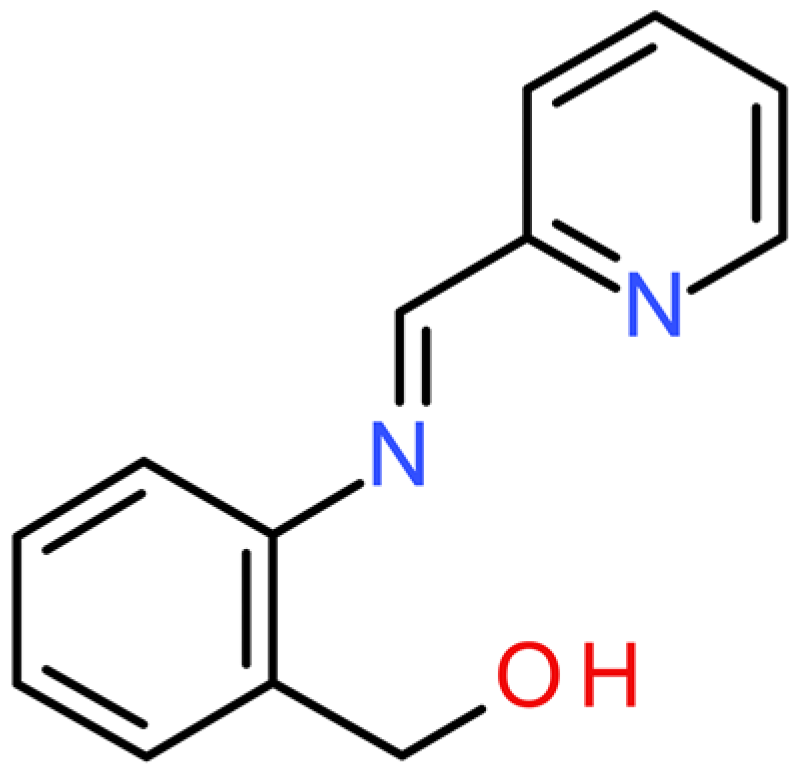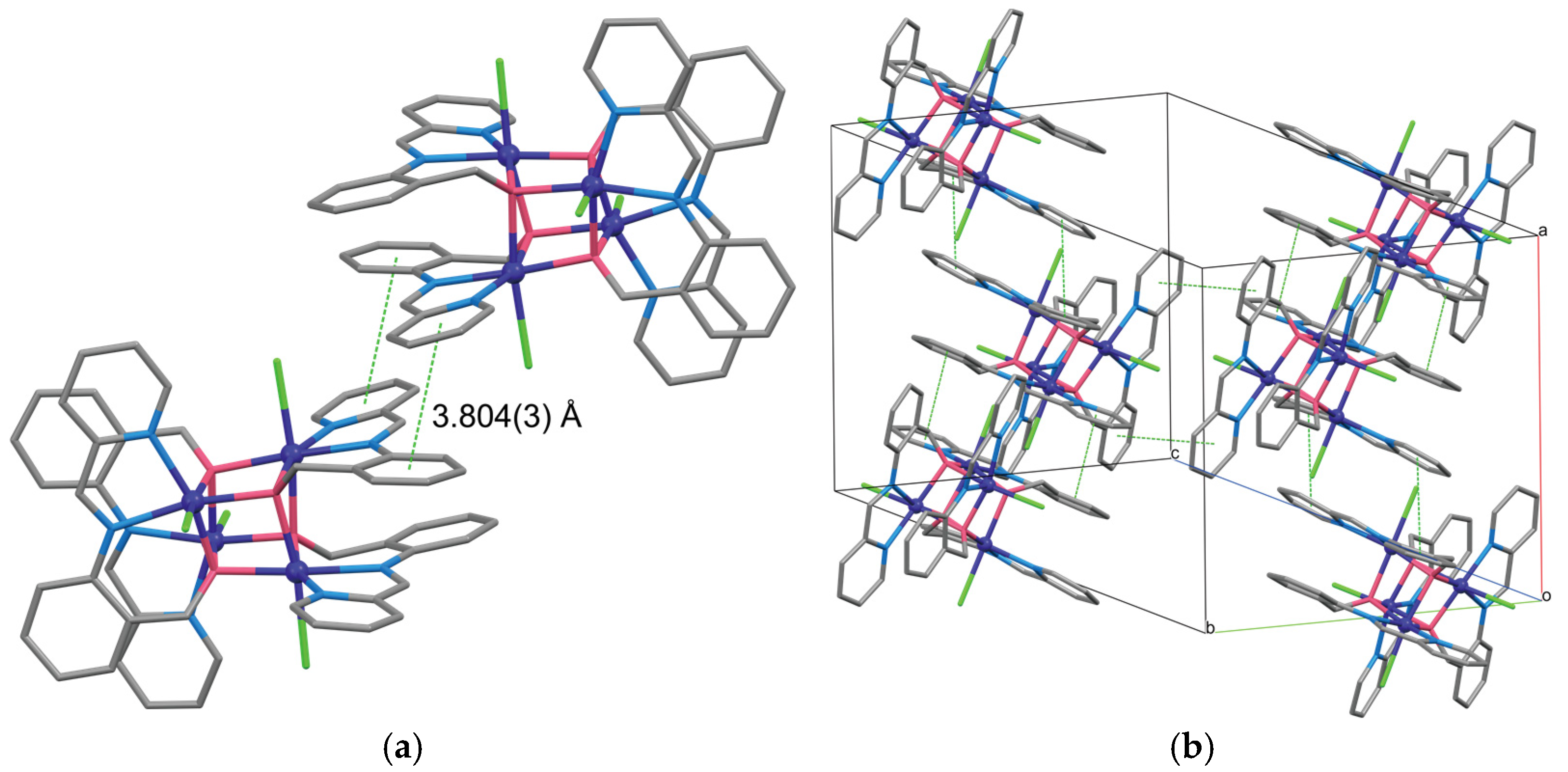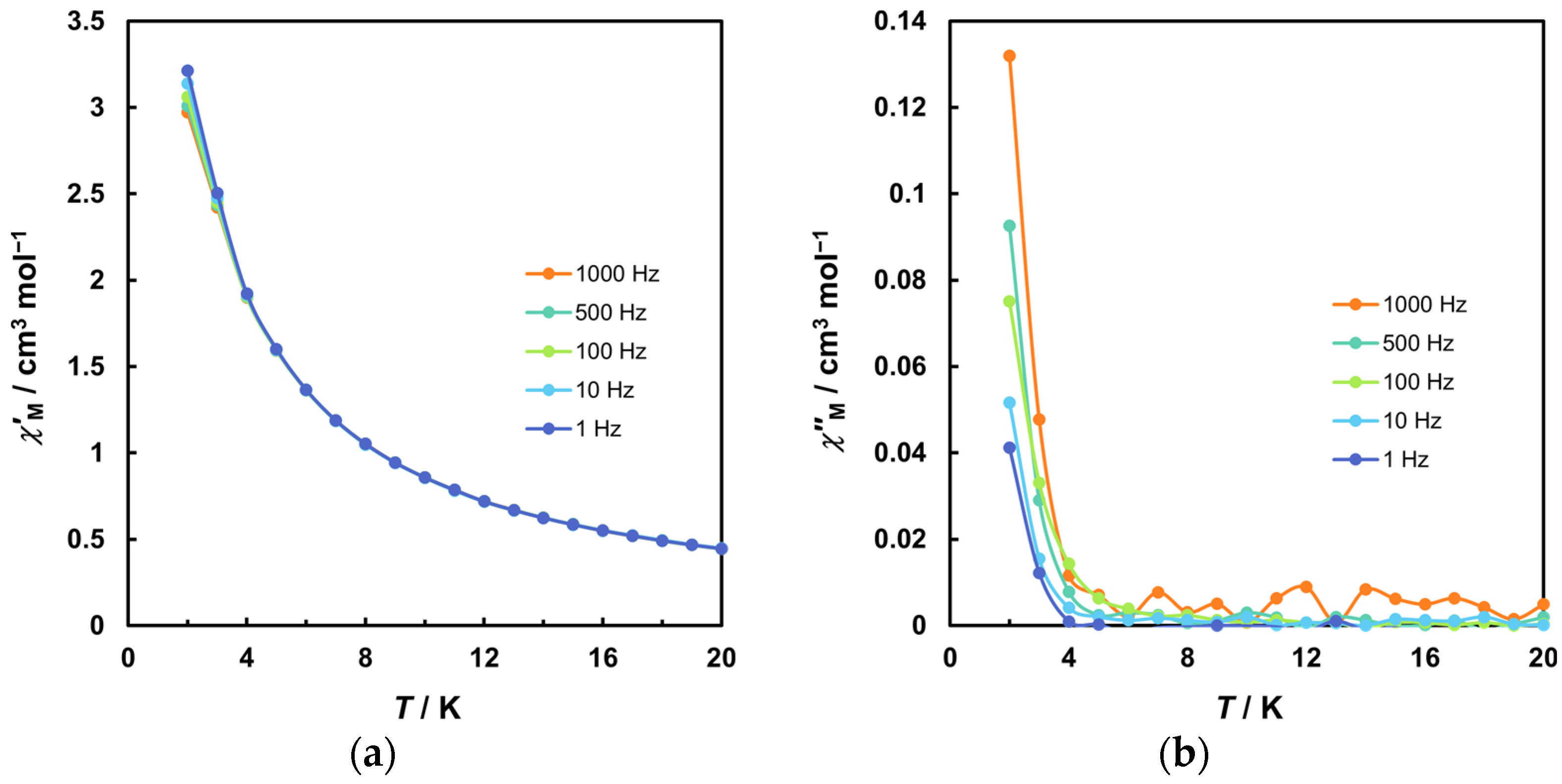Slow Magnetic Relaxation in a [Co4O4] Cubane Complex with Tridentate NNO-Schiff Base Ligands
Abstract
1. Introduction
2. Materials and Methods
2.1. Preparation
2.1.1. Hpmab
2.1.2. [Co4(pmab)4Cl4] (1)
2.1.3. [Co4(pmab)4(OBz)2]Cl2 (2)
2.2. Measurements
2.3. Single Crystal X-Ray Diffraction
3. Results and Discussion
3.1. Synthetic Outcomes and Characterization
3.2. Structural Studies
3.3. Magnetic Properties
4. Conclusions
Supplementary Materials
Author Contributions
Funding
Institutional Review Board Statement
Informed Consent Statement
Data Availability Statement
Acknowledgments
Conflicts of Interest
References
- Sessoli, R.; Gatteschi, D.; Caneschi, A.; Novak, M.A. Magnetic bistability in a metal-ion cluster. Nature 1993, 365, 141–143. [Google Scholar] [CrossRef]
- McClain, K.R.; Gould, C.A.; Chakarawet, K.; Teat, S.J.; Groshens, T.J.; Long, J.R.; Harvey, B.G. High-temperature magnetic blocking and magneto-structural correlations in a series of dysprosium(III) metallocenium single-molecule magnets. Chem. Sci. 2018, 9, 8492–8503. [Google Scholar] [CrossRef] [PubMed]
- Christou, G. Single-molecule magnets: A molecular approach to nanoscale magnetic materials. Polyhedron 2005, 24, 2065–2075. [Google Scholar] [CrossRef]
- Nayak, S.; Aromí, G.; Teat, S.J.; Ribas-Ariño, J.; Gamez, P.; Reedijk, J. Hydrogen bond assisted co-crystallization of a bimetallic MnIII2NiII2 cluster and a NiII2 cluster unit: Synthesis, structure, spectroscopy and magnetism. Dalton Trans. 2010, 39, 4986–4990. [Google Scholar] [CrossRef]
- Hill, S.; Datta, S.; Liu, J.; Inglis, R.; Milios, C.J.; Feng, P.L.; Henderson, J.J.; del Barco, E.; Brechin, E.K.; Hendrickson, D.N. Magnetic quantum tunneling: Insights from simple molecule-based magnets. Dalton Trans. 2010, 39, 4693–4707. [Google Scholar] [CrossRef]
- Colacio, E.; Ruiz-Sanchez, J.; White, F.J.; Brechin, E.K. Strategy for the rational design of asymmetric triply bridged dinuclear 3d-4f single-molecule magnets. Inorg. Chem. 2011, 50, 7268–7273. [Google Scholar] [CrossRef]
- Leuenberger, M.N.; Loss, D. Quantum computing in molecular magnets. Nature 2001, 410, 789–793. [Google Scholar] [CrossRef]
- Hymas, K.; Soncini, A. Molecular spintronics using single-molecule magnets under irradiation. Phys. Rev. B 2019, 99, 245405. [Google Scholar] [CrossRef]
- Zabala-Lekuona, A.; Landart-Gereka, A.; Quesada-Moreno, M.M.; Mota, A.J.; Díaz-Ortega, I.F.; Nojiri, H.; Krzystek, J.; Seco, J.M.; Colacio, E. Zero-field SMM behavior triggered by magnetic exchange interactions and a collinear arrangement of local anisotropy axes in a linear Co3II complex. Inorg. Chem. 2023, 62, 20030–20041. [Google Scholar] [CrossRef]
- Velkos, G.; Krylov, D.S.; Kirkpatrick, K.; Spree, L.; Dubrovin, V.; Büchner, B.; Avdoshenko, S.M.; Bezmelnitsyn, V.; Davis, S.; Faust, P.; et al. High blocking temperature of magnetization and giant coercivity in the azafullerene Tb2@C79N with a single-electron terbium–terbium bond. Angew. Chem. Int. Ed. 2019, 58, 5891–5896. [Google Scholar] [CrossRef]
- Vieru, V.; Gómez-Coca, S.; Ruiz, E.; Chibotaru, L.F. Increasing the magnetic blocking temperature of single-molecule magnets. Angew. Chem. Int. Ed. 2024, 63, e202303146. [Google Scholar] [CrossRef] [PubMed]
- Yang, E.-C.; Harden, N.; Wernsdorfer, W.; Zakharov, L.; Brechin, E.K.; Rheingold, A.L.; Christou, G.; Hendrickson, D.N. Mn4 single-molecule magnets with a planar diamond core and S = 9. Polyhedron 2003, 22, 1857–1863. [Google Scholar] [CrossRef]
- Gatteschi, D.; Sessoli, R.; Cornia, A. Single-molecule magnets based on iron(III) oxo clusters. Chem. Commun. 2000, 725–732. [Google Scholar] [CrossRef]
- Oshio, H.; Hoshino, N.; Ito, T.; Nakano, M. Single-molecule of ferrous cubes: Structurally controlled magnetic anisotropy. J. Am. Chem. Soc. 2004, 126, 8805–8812. [Google Scholar] [CrossRef] [PubMed]
- Yang, E.-C.; Hendrickson, D.N.; Wernsdorfer, W.; Nakano, M.; Zakharov, L.N.; Sommer, R.D.; Rheingold, A.L.; Ledezma-Gairaud, M.; Christou, G. Cobalt single-molecule magnet. J. Appl. Phys. 2002, 91, 7382–7384. [Google Scholar] [CrossRef]
- Zadrozny, J.M.; Liu, J.; Piro, N.A.; Chang, C.J.; Hill, S.; Long, J.R. Slow magnetic relaxation in a pseudotetrahedral cobalt(II) complex with easy-plane anisotropy. Chem. Commun. 2012, 48, 3927–3929. [Google Scholar] [CrossRef]
- Vallejo, J.; Castro, I.; Ruiz-García, R.; Cano, J.; Julve, M.; Lloret, F.; De Munno, G.; Wernsdorfer, W.; Pardo, E. Field-induced slow magnetic relaxation in a six-coordinate mononuclear cobalt(II) complex with a positive anisotropy. J. Am. Chem. Soc. 2012, 134, 15704–15707. [Google Scholar] [CrossRef]
- Guedes, G.P.; Soriano, S.; Comerlato, N.M.; Speziali, N.L.; Lahti, P.M.; Novak, M.A.; Vaz, M.G.F. Two cobalt(II) cubane compounds: The key role of small ligand changes on the crystal packing and magnetic properties. Eur. J. Inorganica Chem. 2012, 2012, 5642–5648. [Google Scholar] [CrossRef]
- Zhang, S.-H.; Zhang, Y.D.; Zou, H.H.; Guo, J.J.; Li, H.P.; Song, Y.; Liang, H. A family of cubane cobalt and nickel clusters: Syntheses, structures and magnetic properties. Inorganica Chim. Acta 2013, 396, 119–125. [Google Scholar] [CrossRef]
- Ma, X.-F.; Wang, Z.; Chen, X.-L.; Kurmoo, M.; Zeng, M.-H. Ligand effect on the single-molecule magnetism of tetranuclear Co(II) cubane. Inorg. Chem. 2017, 56, 15178–15186. [Google Scholar] [CrossRef]
- Wu, Y.; Xi, J.; Xiao, T.; Ferrando-Soria, J.; Ouyang, Z.; Wang, Z.; Luo, S.; Liu, X.; Pardo, E. Switching of easy-axis to easy-plane anisotropy in cobalt(II) complexes. Inorg. Chem. Front. 2021, 8, 5158–5168. [Google Scholar] [CrossRef]
- Modak, R.; Sikdar, Y.; Thuijs, A.E.; Christou, G.; Goswami, S. CoII4, CoII7, and a series of CoII2LnIII (LnIII = NdIII, SmIII, GdIII, TbIII, DyIII) coordination clusters: Search for single molecule magnets. Inorg. Chem. 2016, 55, 10192–10202. [Google Scholar] [CrossRef] [PubMed]
- Zeng, M.-H.; Yao, M.-X.; Liang, H.; Zhang, W.-X.; Chen, X.-M. A single-molecule-magnetic, cubane-based, triangular Co12 supercluster. Angew. Chem. Int. Ed. 2007, 46, 1832–1835. [Google Scholar] [CrossRef] [PubMed]
- Hill, S.; Edwards, R.S.; Aliaga-Alcalde, N.; Christou, G. Quantum coherence in an exchange-coupled dimer of single-molecule magnets. Science 2003, 302, 1015–1018. [Google Scholar] [CrossRef] [PubMed]
- Zhang, S.-H.; Li, N.; Ge, C.-M.; Feng, C.; Ma, L.-F. Structures and magnetism of {Ni2Na2}, {Ni4} and {Ni6IINiIII} 2-hydroxy-3-alkoxy-benzaldehyde clusters. Dalton Trans. 2011, 40, 3000–3007. [Google Scholar] [CrossRef]
- Saseendran, D.P.A.; Fischer, J.W.A.; Müller, L.; Abbott, D.F.; Mougel, V.; Jeschke, G.; Triana, C.A.; Patzke, G.R. Copper(II) defect-cubane water oxidation electrocatalysts: From molecular tetramers to oxidic nanostructures. Chem. Commun. 2023, 59, 5866–5869. [Google Scholar] [CrossRef]
- Sun, H.; Zhang, J.; Cai, Y.; Liu, W.; Zhang, X.; Dong, Y.; Li, Y. Syntheses, structures, and magnetic properties of a cubane-like {Co4O4} cluster and a dinuclear CuII compound constructed from a tridentate Schiff base ligand. Polyhedron 2017, 125, 135–140. [Google Scholar] [CrossRef]
- Galloway, K.W.; Whyte, A.M.; Wernsdorfer, W.; Sanchez-Benitez, J.; Kamenev, K.V.; Parkin, A.; Peacock, R.D.; Murrie, M. Cobalt(II) citrate cubane single-molecule magnet. Inorg. Chem. 2008, 47, 7438–7442. [Google Scholar] [CrossRef]
- Koikawa, M.; Ohba, M.; Tokii, T. Syntheses, structures, and magnetic properties of tetranuclear NiII4 and NiII2MnIII2 complexes with ONO tridentate ligands. Polyhedron 2005, 24, 2257–2262. [Google Scholar] [CrossRef]
- Fukuda, M.; Eguchi, K.; Matsumoto, K.; Yoneda, K.; Yamada, Y.; Yoshino, H.; Imamura, Y.; Yamamoto, N.; Ohba, M.; Koikawa, M. Novel tetranuclear heterometallic Mn3Ni and mononuclear Ni complexes with an ONO Schiff base ligand: Synthesis, crystal structures, and magnetic properties. Magnetochemistry 2023, 9, 225. [Google Scholar] [CrossRef]
- Selwood, P.W. Magnetochemistry; Interscience Publishers: New York, NY, USA, 1956; pp. 78–91. [Google Scholar]
- Rigaku Corporation. CrystalClear: Data Collection and Processing Software; Rigaku Corporation: Tokyo, Japan, 1998. [Google Scholar]
- Rigaku Oxford Diffraction. CrysAlis Pro; Rigaku Oxford Diffraction: Tokyo, Japan, 2022. [Google Scholar]
- Sheldrick, G.M. SHELXT—Integrated space-group and crystal-structure determination. Acta Crystallogr. Sect. A Found. Adv. 2015, 71, 3–8. [Google Scholar] [CrossRef] [PubMed]
- Jiang, J.-S.; Brünger, A.T. Protein hydration observed by X-ray diffraction: Solvation properties of penicillopepsin and neuraminidase crystal structures. J. Molec. Biol. 1994, 243, 100–115. [Google Scholar] [CrossRef] [PubMed]
- Sheldrick, G.M. Crystal structure refinement with SHELXL. Acta Crystallogr. Sect. C Struct. Chem. 2015, 71, 3–8. [Google Scholar] [CrossRef] [PubMed]
- Dolomanov, O.V.; Bourhis, L.J.; Gildea, R.J.; Howard, J.A.K.; Puschmann, H. OLEX2: A complete structure solution, refinement and analysis program. J. Appl. Cryst. 2009, 42, 339–341. [Google Scholar] [CrossRef]
- Macrae, C.F.; Sovago, I.; Cottrell, S.J.; Galek, P.T.A.; McCabe, P.; Pidcock, E.; Platings, M.; Shields, G.P.; Stevens, J.S.; Towler, M.; et al. Mercury 4.0: From visualization to analysis, design and prediction. J. Appl. Crystallogr. 2020, 53, 226–235. [Google Scholar] [CrossRef] [PubMed]
- Deacon, G.B.; Phillips, R.J. Relationships between the carbon-oxygen stretching frequencies of carboxylato complexes and the type of carboxylate coordination. Coord. Chem. Rev. 1980, 33, 227–250. [Google Scholar] [CrossRef]
- Llunell, M.; Casanova, D.; Cirera, J.; Alemany, P.; Alvarez, S. SHAPE, Version 2.1; University of Barcelona: Barcelona, Spain, 2013. [Google Scholar]
- O’Connor, C.J. Magnetochemistry–Advances in theory and experimentation. In Progress in Inorganic Chemistry; Lippard, S.J., Ed.; John Wiley & Sons: New York, NY, USA, 1982; Volume 29, pp. 203–283. [Google Scholar] [CrossRef]
- Chilton, N.F.; Anderson, R.P.; Turner, L.D.; Soncini, A.; Murray, K.S. PHI: A powerful new program for the analysis of anisotropic monomeric and exchange-coupled polynuclear d- and f-block complexes. J. Comput. Chem. 2013, 34, 1164–1175. [Google Scholar] [CrossRef]
- Murrie, M.; Teat, S.J.; Stœckli-Evans, H.; Güdel, H.U. Synthesis and characterization of a cobalt(II) single-molecule magnet. Angew. Chem. Int. Ed. 2003, 42, 4653–4656. [Google Scholar] [CrossRef]
- Hudson, T.A.; Berry, K.J.; Moubaraki, B.; Murray, K.S.; Robson, R. Citrate, in collaboration with a guanidinium ion, as a generator of cubane-like complexes with a range of metal cations: Synthesis, structures, and magnetic properties of [C(NH2)3]8[(MII)4(cit)4]∙8H2O (M = Mg, Mn, Fe, Co, Ni, and Zn; cit = citrate). Inorg. Chem. 2006, 45, 3549–3556. [Google Scholar] [CrossRef]
- Tian, C.B.; Zhang, H.-B.; Peng, Y.; Xie, Y.-E.; Lin, P.; Li, Z.-H.; Du, S.-W. Synthesis, structures, and magnetic properties of three 3D coordination polymers based on M4O4 cubanes (M = MnII, FeII, CoII). Eur. J. Inorg. Chem. 2012, 2012, 4029–4035. [Google Scholar] [CrossRef]
- Zhang, S.-H.; Ma, L.-F.; Zou, H.-H.; Wang, Y.G.; Liang, H.; Zeng, M.H. Anion induced diversification from heptanuclear to tetranuclear clusters: Syntheses, structures and magnetic properties. Dalton Trans. 2011, 40, 11402–11409. [Google Scholar] [CrossRef] [PubMed]
- Bartolomé, J.; Filoti, G.; Kuncser, V.; Schinteie, G.; Mereacre, V.; Anson, C.E.; Powell, A.K.; Prodius, D.; Turta, C. Magnetostructural correlations in the tetranuclear series of {Fe3LnO2} butterfly core clusters: Magnetic and Mössbauer spectroscopic study. Phys. Rev. B 2009, 80, 014430. [Google Scholar] [CrossRef]
- Gao, Q.; Qin, Y.; Chen, Y.; Liu, W.; Li, H.; Wu, B.; Li, Y.; Li, W. Cubane-type {M4O4} (M = CoII, ZnII, CuII) clusters: Synthesis, crystal structures, and luminescent and magnetic properties. RSC Adv. 2015, 5, 43195–43201. [Google Scholar] [CrossRef]
- Bhattacharya, P.; Bag, R.; Satpathi, S.; Pati, S.K.; Butcher, R.J.; Tang, J.; Goswami, S. Structure and magnetism of LnIII2 (Ln = Gd, Tb, Dy, and Ho) assemblies constructed from a bis(hydrazone) compartmental ligand: Slow magnetic relaxation in the DyIII2 analogue. Cryst. Growth Des. 2023, 33, 7459–7471. [Google Scholar] [CrossRef]
- Kalinke, L.H.G.; Rabelo, R.; Valdo, A.K.; Martins, F.T.; Moliner, N.; Ferrando-Soria, J.; Julve, M.; Lloret, F.; Cano, J.; Cangussu, D. Trinuclear cobalt(II) triple helicate with a multidentate bithiazolebis(oxamate) ligand as a supramolecular nanomagnet. Inorg. Chem. 2022, 61, 5696–5700. [Google Scholar] [CrossRef]









| Bond | Distance/Å | Angle | Angle/° |
|---|---|---|---|
| Co1–Cl1 | 2.4763(12) | Cl1–Co1–O1′ | 170.11(7) |
| Co1–O1 | 2.028(3) | O1–Co1–N2 | 162.00(12) |
| Co1–O1′ | 2.194(3) | O1′–Co1–N1 | 168.09(12) |
| Co1–O1′’ | 2.109(2) | O1–Co1–N1 | 87.13(11) |
| Co1–N1 | 2.169(3) | N1–Co1–N2 | 77.81(13) |
| Co1–N2 | 2.103(3) | O1–Co1–O1″ | 81.19(10) |
| Co1···Co1′ | 3.1398(11) | O1″–Co1–N2 | 114.09(12) |
| Co1···Co1″ | 3.2371(7) | Co1–O1–Co1′ | 96.03(10) |
| Co1–O1–Co1‴ | 102.96(11) | ||
| Co1′–O1–Co1‴ | 97.56(10) |
| Bond | Distance/Å | Angle | Angle/° |
|---|---|---|---|
| Co1–O1 | 2.138(5) | O1–Co1–N2 | 165.8(2) |
| Co1–O11 | 2.127(5) | O12–Co1–O2 | 170.5(2) |
| Co1–O12 | 2.091(5) | O11–Co1–N1 | 175.7(2) |
| Co1–O2 | 2.077(5) | O1–Co1–N1 | 88.4(2) |
| Co1–N1 | 2.144(7) | N1–Co1–N2 | 78.6(3) |
| Co1–N2 | 2.184(7) | O1–Co1–O12 | 87.5(2) |
| O12–Co1–N2 | 105.6(2) | ||
| Co1···Co11 | 2.978(2) | Co1–O1–Co11 | 88.57(18) |
| Co1···Co12 | 3.2561(17) | Co1–O1–Co13 | 100.7(2) |
| Co11–O1–Co13 | 101.1(2) |
| Complex | J/cm−1 | J′/cm−1 | g | λ/cm−1 | κ | Δ/cm−1 |
|---|---|---|---|---|---|---|
| 1 | +0.75 | −0.015 | 2.22 | −180 | 0.955 | −44.3 |
| 2 | −6.08 | −0.629 | 2.29 | −140 | 1.09 | −6.13 |
Disclaimer/Publisher’s Note: The statements, opinions and data contained in all publications are solely those of the individual author(s) and contributor(s) and not of MDPI and/or the editor(s). MDPI and/or the editor(s) disclaim responsibility for any injury to people or property resulting from any ideas, methods, instructions or products referred to in the content. |
© 2024 by the authors. Licensee MDPI, Basel, Switzerland. This article is an open access article distributed under the terms and conditions of the Creative Commons Attribution (CC BY) license (https://creativecommons.org/licenses/by/4.0/).
Share and Cite
Suemitsu, Y.; Amakusa, Y.; Yoshino, H.; Ohba, M.; Koikawa, M. Slow Magnetic Relaxation in a [Co4O4] Cubane Complex with Tridentate NNO-Schiff Base Ligands. Magnetochemistry 2024, 10, 85. https://doi.org/10.3390/magnetochemistry10110085
Suemitsu Y, Amakusa Y, Yoshino H, Ohba M, Koikawa M. Slow Magnetic Relaxation in a [Co4O4] Cubane Complex with Tridentate NNO-Schiff Base Ligands. Magnetochemistry. 2024; 10(11):85. https://doi.org/10.3390/magnetochemistry10110085
Chicago/Turabian StyleSuemitsu, Yuki, Yoshitaka Amakusa, Haruka Yoshino, Masaaki Ohba, and Masayuki Koikawa. 2024. "Slow Magnetic Relaxation in a [Co4O4] Cubane Complex with Tridentate NNO-Schiff Base Ligands" Magnetochemistry 10, no. 11: 85. https://doi.org/10.3390/magnetochemistry10110085
APA StyleSuemitsu, Y., Amakusa, Y., Yoshino, H., Ohba, M., & Koikawa, M. (2024). Slow Magnetic Relaxation in a [Co4O4] Cubane Complex with Tridentate NNO-Schiff Base Ligands. Magnetochemistry, 10(11), 85. https://doi.org/10.3390/magnetochemistry10110085






